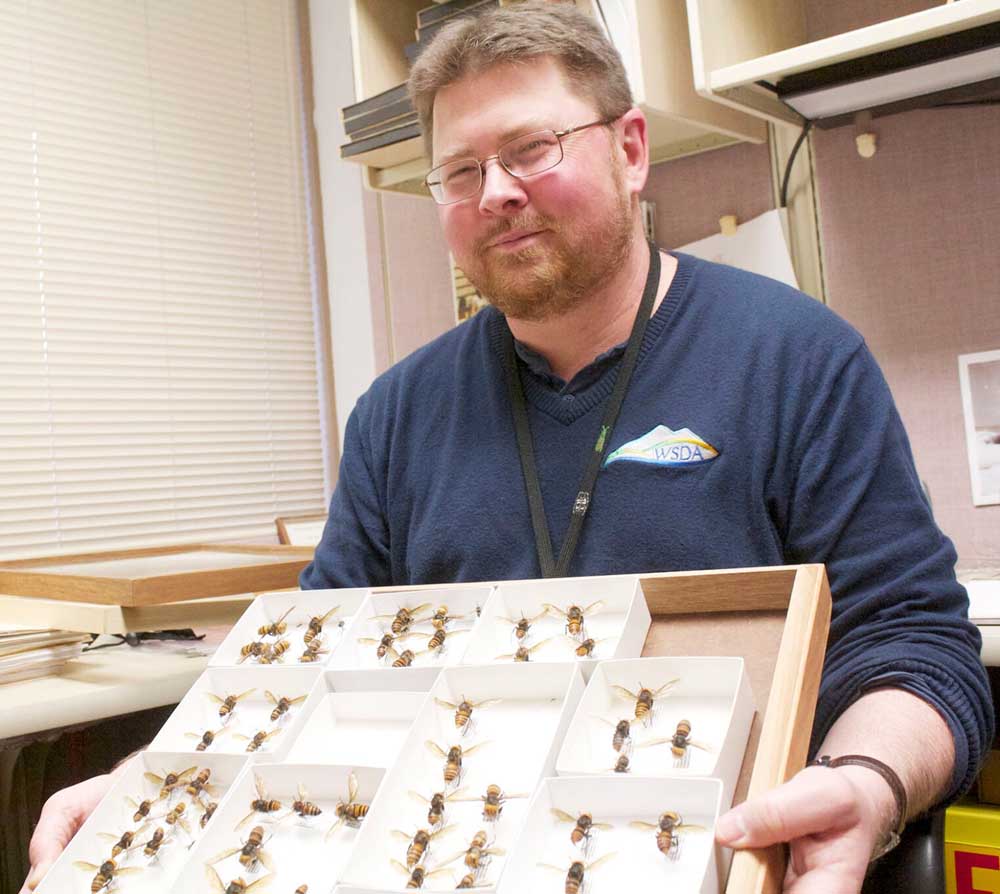Western Innovator: Giant hornets thrust entomologist into spotlight
Published 3:15 pm Thursday, December 16, 2021

- Washington State Department of Agriculture managing entomologist Sven-Erik Spichiger holds a tray of Asian giant hornet specimens. Spichiger spearheads the state’s response to the hornet, but it’s not the invasive insect that he calls the “pest of a generation.”
It was not astonishing to Sven-Erik Spichiger that the Asian giant hornet popped up in Washington state.
Trending
Shortly before the insect, sensationally dubbed the “murder hornet,” was found near the U.S.-Canadian border in 2019, the Washington State Department of Agriculture printed a booklet on “invasive pests.”
The rogues gallery included Vespa mandarinia, the world’s largest hornet. The fearsome decapitators of honey bees had never been confirmed in North America. But Spichiger, the agriculture department’s managing entomologist, was expecting them to arrive by ship.
“The way our trade routes are set up, I’m surprised it didn’t happen before,” he said.
Trending
Imported delicacy?
The hornets that were found in British Columbia and northwest Washington could have been stowaways — or they could have escaped.
“Asian giant hornets are a sought-after food source,” Spichiger said. “It’s possible people brought them here on purpose.
“You wonder whether somebody tried to get a colony going to enjoy them,” said Spichiger, who was tempted into trying raw hornet pupae. “It tastes like any other insect,” he said.
Reluctant spokesman
For two years, Spichiger, 49, has been the introverted but quotable scientist informing the public about the campaign to repel Asian giant hornets.
He reported the missteps, victories, surprises and lucky breaks. He says he doesn’t relish the role he’s been thrust into, but likes that people are listening and on-guard.
So far, with the public’s help, Spichiger and colleagues, including fellow department entomologist Chris Looney, have found and destroyed four nests, all near each other in Whatcom County.
Spichiger said in November that he was hopeful the hornets have been contained to a small area along the border. Murder hornets, however, remain a story of national interest.
“We expected people to be interested. We didn’t expect people to be this interested for this long,” he said. “We’re not used to people being interested in what we do.”
Boyhood interest
Spichiger traces his interest in insects to the summer he was 8 and helped his cousin earn a Boy Scout merit badge by collecting green dragonflies. He never stopped collecting.
He earned a bachelor’s degree in entomology at Penn State University and a master’s degree in the same subject at Clemson University.
A Pennsylvania native, Spichiger worked his way up to managing entomologist at the Pennsylvania Department of Agriculture. By 2018, he was attending lots of meetings and doing paperwork.
A bug crisis arose while he was on jury duty, and his staff handled the problem without him. That’s when he knew it was time for a change.
Spichiger applied, as a lark, for an equivalent position in Washington.
He was offered the job, so he and his wife, Kuen Kuen, moved west, where the mountains and fish are bigger. “We feel like we’re on vacation every day,” he said.
Spichiger said he became an entomologist for the “wondrous variety.”
There’s a new infestation of Japanese beetles to attack next spring in Yakima County. “Japanese beetles could be a disaster. It could be ho-hum,” Spichiger said.
Spotted lnternfly
There’s another insect that Spichiger would never describe as humdrum. He says it “could be one the most harmful pests in our generation.”
It’s the spotted lanternfly. There’s never been a credible sighting in Washington, but Spichigher fought the pest in Pennsylvania, and he expects to do so again.
“It is coming,” he said.
In 2014, Spichiger, as Pennsylvania’s entomologist, checked out a report of an unusual insect. He found hundreds of spotted lanternflies on Ailanthus altimssim, commonly known as tree of heaven.
Spotted lanternflies prefer those trees, which are fast-growing, but they also like grapes, apples, Christmas trees and many other crops.
Until Spichiger saw that tree, the insect had never been confirmed in the U.S. Reflecting a few years later, Spichiger said the report “gave us a chance.”
It was, however, the pest that got away. “We didn’t hit it hard enough,” Spichiger said. “We should have nuked the area.”
If that sounds harsh, consider this: The spotted lanternfly infestation grew from 174 square miles in 2016 to about 3,000 square miles in 2017, according to the Pennsylvania Department of Agriculture.
In 2018, a Pennsylvania congressman complained the pest was “wreaking havoc” on agriculture in 13 counties. The USDA announced it would spend $17.5 million to contain the bug.
The pest continued to spread. Penn State researchers in late 2019 estimated the potential economic damage. Worst-case, if the pest gets established, annual losses are projected to be $554 million.
Spotted lanternflies spread by laying egg masses on the surface of items that can travel around the country. The USDA says spotted lanternflies are now in 11 states, the farthest west being Indiana.
Spichiger said he’s watching Cleveland, where spotted lanternflies were found in August. He said that he expects that once they hit Chicago, they will spread west on rail cars.
“Once it gets here, we’re looking at managing it, living with it,” he said.
By contrast, the Asian giant hornet “will never be the pest of a generation,” he said.
“It’s just the one people are interested in.”
Position: Washington State Department of Agriculture managing entomologist
Previously: Pennsylvania Department of Agriculture managing entomologist
Education: Bachelor’s degree in entomology, Penn State University; master’s degree in entomology, Clemson University









